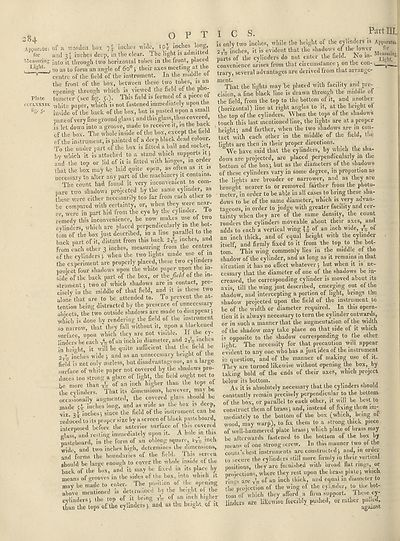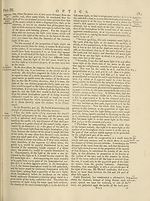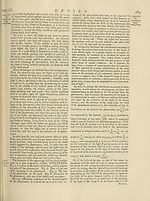Encyclopaedia Britannica > Volume 15, NIC-PAR
(304) Page 284
Download files
Complete book:
Individual page:
Thumbnail gallery: Grid view | List view

Plate
cccvxxxix
5-
O P T
of a Vvaodea box 7^ inches wide, 10J inches long,
and 31 inches deep, in the clear. The light is admitted
into it through two horizontal tubes in the Iront, placed
so as to form an angle of 6o° ; their axes meeting at the
centre of the field of the instrument. In the middle ot
the front of the box, between these two tubes, is an
opening through which is viewed the field ol the pho¬
tometer (see fig. 5.). This field is formed of a piece oi
white paper, which is not fastened immediately upon the
inside of the hack of the box, but is pasted upon a sma l
pane of very fine ground glass •, and this glass, thus covered,
is let down into a groove, made to receive it, in the back
of the box. The whole inside of the box, except the field
of the instrument, is painted of a deep black dead colour.
To the under part of the box is fitted a ball and socket,
j)Y which it is attached to a stand which supports it 5
and the top or lid of it is fitted with hinges, in order
that the box may he laid quite open, as often as it is
necessary to alter any part of the machinery it contains.
The count had found it very inconvenient to com¬
pare two shadows projected by the same cylinder, as
these were either necessarily too far from each other to
be compared with certainty, or, when they were near¬
er, were in part hid from the eye by the cylinder, lo
remedy this inconvenience, he now makes use ot two
cylinders, which are placed perpendicularly in the bot¬
tom of the box just described, in a line parallel to the
back part of it, distant from this hack 2tct inches, and
from each other 3 inches, measuring from the centres
of the cylinders; when the two lights made use ot 111
the experiment are properly placed, these two cylinders
project four shadows upon the white paper upon the m-
feide of the back part of the box, or the field ol the in¬
strument ; two of which shadows are in contact, pre¬
cisely in the middle of that field, and it is these two
alone that are to be attended to. To prevent the at¬
tention being distracted by the presence of unnecessaiy
objects, the two outside shadows are made to disappear;
which is done by rendering the field of the instrument
so narrow, that they fall without it, upon a blackened
surface, upon which they are not visible. It the cy¬
linders he each A of an inch in diameter, and 2A inches
in height, it will he quite sufficient that the field be
o-1- inches wide 5 and as an unnecessary height ol the
field is not only useless, but disadvantageous, as a large
surface of white paper not covered by the shadows pro¬
duces too strong a glare of light, the field ought not to
be more than A of an inch higher than the tops ot
the cylinders. That its dimensions, however, may be
occasionally augmented, the covered glass should be
made A inches long, and as wide as. the box is deep,
viz. 3^ inches; since the field of the instrument can be
reduced to its proper size by a screen of black pasteboard,
interposed before the anterior surface of this covered
Flass, and resting immediately upon it. A hole in this
pasteboard, in the form of an oblong square, iTo- inch
wide and two inches high, determines tlm dimensions,
and forms the boundaries of the field. 'Hus screen
should be large enough to cover the whole inside ol the
back of the box, and it may be fixed in its place l>y
means of grooves in the sides ot the box, into which it
may be made to enter. The position of the opening
above mentioned is determined by the height ot the
cylinders; the top of it being A of an inch higher
than the tops of the cylinders; and as the height ol it
ICS. Partlll,,
is only two inches, while the height of the cylinders is Apparatus
2t— inches, it is evident that the shadows of the lower for
X of tile cylinders do not enter the field. No m-
convenience arises from that circumstance; on toe con-
trary, several advantages are derived horn that arrange¬
ment. ... .
That the lights may be placed with lacility ami pre¬
cision, a fine black line is drawn through the middle of
the field, from the top to the bottom of it, and another
(horizontal) line at right angles to it, at the height ol
the top of the cylinders. When the tops of the shadows
touch this last mentioned line, the lights are at a proper
height; and farther, when the two shadows are in con¬
tact with each other in the middle of the field, the
lio-hts are then in their proper directions.
&\Ve have said that the cylinders, by which the sha¬
dows are projected, are placed perpendicularly in the
bottom of the box; hut as the diameters of the shadows
of these cylinders vary in some degree, in proportion as
the lights are broader or narrower, and as they are
brought nearer to or removed farther from the photo¬
meter, in order to be able in all cases to bring these sha¬
dows to be of the same diameter, which is very advan¬
tageous, in order to judge with greater facility and cer¬
tainty when they are ot the same density, the count
renders the cylinders moveable about their axes, and
adds to each a vertical wing A an ;nc^ vvhle, to 01
an inch thick, and ot equal height with the cylinder
itself, and firmly fixed to it from the top to the bot¬
tom. ’ This wing commonly lies in the middle of the
shadow of the cylinder, and as long as it remains in that
situation it has no effect whatever; but when it is ne¬
cessary that the diameter of one of the shadows be in¬
creased, the corresponding cylinder is moved about its
axis, till the wing just described, emerging out of the
shadow, and intercepting a portion of light, brings the
shadow projected upon the field ot the instrument to
be of the width or diameter required. In this opera¬
tion it is always necessary to turn the cylinder outwards,
or in such a manner that the augmentation of the width
of the shadow may take place on that side of it which
is opposite to the shadow corresponding to the other
light. The necessity for that precaution will appear
evident to any one. who has a just idea of the instrument
in question, and of the manner of making use ol it.
They are turned likewise without opening the box, by
taking hold of the ends of their axes, which project
below its bottom.
As it is absolutely necessary that the cylinders should
constantly remain precisely perpendicular to the bottom
of the box, or parallel to each other, it will be best to
construct them of brass; and, instead of fixing them im¬
mediately to the bottom of the box (which, being or
Wood, may warp), to fix them to a strong thick piece
of well-hammered plate brass; which plate ot brass may
be afterwards fastened to the bottom ol the box by
means of one strong screw. In this manner two of the
count's best instruments are constructed; and, in order
to secure the cylinders still more firmly in their vertical
positions, they are furnished with broad flat rings, or
projections, where they rest upon the brass plate; which
rings are A of an inch thick, and equal in diameter to
the projection of the wing of the cylinder, to Hie bot¬
tom of which they afford a firm support. These cy¬
linders are likewise forcibly pushed, or rather pulled,
against
cccvxxxix
5-
O P T
of a Vvaodea box 7^ inches wide, 10J inches long,
and 31 inches deep, in the clear. The light is admitted
into it through two horizontal tubes in the Iront, placed
so as to form an angle of 6o° ; their axes meeting at the
centre of the field of the instrument. In the middle ot
the front of the box, between these two tubes, is an
opening through which is viewed the field ol the pho¬
tometer (see fig. 5.). This field is formed of a piece oi
white paper, which is not fastened immediately upon the
inside of the hack of the box, but is pasted upon a sma l
pane of very fine ground glass •, and this glass, thus covered,
is let down into a groove, made to receive it, in the back
of the box. The whole inside of the box, except the field
of the instrument, is painted of a deep black dead colour.
To the under part of the box is fitted a ball and socket,
j)Y which it is attached to a stand which supports it 5
and the top or lid of it is fitted with hinges, in order
that the box may he laid quite open, as often as it is
necessary to alter any part of the machinery it contains.
The count had found it very inconvenient to com¬
pare two shadows projected by the same cylinder, as
these were either necessarily too far from each other to
be compared with certainty, or, when they were near¬
er, were in part hid from the eye by the cylinder, lo
remedy this inconvenience, he now makes use ot two
cylinders, which are placed perpendicularly in the bot¬
tom of the box just described, in a line parallel to the
back part of it, distant from this hack 2tct inches, and
from each other 3 inches, measuring from the centres
of the cylinders; when the two lights made use ot 111
the experiment are properly placed, these two cylinders
project four shadows upon the white paper upon the m-
feide of the back part of the box, or the field ol the in¬
strument ; two of which shadows are in contact, pre¬
cisely in the middle of that field, and it is these two
alone that are to be attended to. To prevent the at¬
tention being distracted by the presence of unnecessaiy
objects, the two outside shadows are made to disappear;
which is done by rendering the field of the instrument
so narrow, that they fall without it, upon a blackened
surface, upon which they are not visible. It the cy¬
linders he each A of an inch in diameter, and 2A inches
in height, it will he quite sufficient that the field be
o-1- inches wide 5 and as an unnecessary height ol the
field is not only useless, but disadvantageous, as a large
surface of white paper not covered by the shadows pro¬
duces too strong a glare of light, the field ought not to
be more than A of an inch higher than the tops ot
the cylinders. That its dimensions, however, may be
occasionally augmented, the covered glass should be
made A inches long, and as wide as. the box is deep,
viz. 3^ inches; since the field of the instrument can be
reduced to its proper size by a screen of black pasteboard,
interposed before the anterior surface of this covered
Flass, and resting immediately upon it. A hole in this
pasteboard, in the form of an oblong square, iTo- inch
wide and two inches high, determines tlm dimensions,
and forms the boundaries of the field. 'Hus screen
should be large enough to cover the whole inside ol the
back of the box, and it may be fixed in its place l>y
means of grooves in the sides ot the box, into which it
may be made to enter. The position of the opening
above mentioned is determined by the height ot the
cylinders; the top of it being A of an inch higher
than the tops of the cylinders; and as the height ol it
ICS. Partlll,,
is only two inches, while the height of the cylinders is Apparatus
2t— inches, it is evident that the shadows of the lower for
X of tile cylinders do not enter the field. No m-
convenience arises from that circumstance; on toe con-
trary, several advantages are derived horn that arrange¬
ment. ... .
That the lights may be placed with lacility ami pre¬
cision, a fine black line is drawn through the middle of
the field, from the top to the bottom of it, and another
(horizontal) line at right angles to it, at the height ol
the top of the cylinders. When the tops of the shadows
touch this last mentioned line, the lights are at a proper
height; and farther, when the two shadows are in con¬
tact with each other in the middle of the field, the
lio-hts are then in their proper directions.
&\Ve have said that the cylinders, by which the sha¬
dows are projected, are placed perpendicularly in the
bottom of the box; hut as the diameters of the shadows
of these cylinders vary in some degree, in proportion as
the lights are broader or narrower, and as they are
brought nearer to or removed farther from the photo¬
meter, in order to be able in all cases to bring these sha¬
dows to be of the same diameter, which is very advan¬
tageous, in order to judge with greater facility and cer¬
tainty when they are ot the same density, the count
renders the cylinders moveable about their axes, and
adds to each a vertical wing A an ;nc^ vvhle, to 01
an inch thick, and ot equal height with the cylinder
itself, and firmly fixed to it from the top to the bot¬
tom. ’ This wing commonly lies in the middle of the
shadow of the cylinder, and as long as it remains in that
situation it has no effect whatever; but when it is ne¬
cessary that the diameter of one of the shadows be in¬
creased, the corresponding cylinder is moved about its
axis, till the wing just described, emerging out of the
shadow, and intercepting a portion of light, brings the
shadow projected upon the field ot the instrument to
be of the width or diameter required. In this opera¬
tion it is always necessary to turn the cylinder outwards,
or in such a manner that the augmentation of the width
of the shadow may take place on that side of it which
is opposite to the shadow corresponding to the other
light. The necessity for that precaution will appear
evident to any one. who has a just idea of the instrument
in question, and of the manner of making use ol it.
They are turned likewise without opening the box, by
taking hold of the ends of their axes, which project
below its bottom.
As it is absolutely necessary that the cylinders should
constantly remain precisely perpendicular to the bottom
of the box, or parallel to each other, it will be best to
construct them of brass; and, instead of fixing them im¬
mediately to the bottom of the box (which, being or
Wood, may warp), to fix them to a strong thick piece
of well-hammered plate brass; which plate ot brass may
be afterwards fastened to the bottom ol the box by
means of one strong screw. In this manner two of the
count's best instruments are constructed; and, in order
to secure the cylinders still more firmly in their vertical
positions, they are furnished with broad flat rings, or
projections, where they rest upon the brass plate; which
rings are A of an inch thick, and equal in diameter to
the projection of the wing of the cylinder, to Hie bot¬
tom of which they afford a firm support. These cy¬
linders are likewise forcibly pushed, or rather pulled,
against
Set display mode to:
![]() Universal Viewer |
Universal Viewer | ![]() Mirador |
Large image | Transcription
Mirador |
Large image | Transcription
Images and transcriptions on this page, including medium image downloads, may be used under the Creative Commons Attribution 4.0 International Licence unless otherwise stated. ![]()
| Encyclopaedia Britannica > Encyclopaedia Britannica > Volume 15, NIC-PAR > (304) Page 284 |
|---|
| Permanent URL | https://digital.nls.uk/192585650 |
|---|
| Attribution and copyright: |
|
|---|
| Shelfmark | EB.11 |
|---|---|
| Description | Ten editions of 'Encyclopaedia Britannica', issued from 1768-1903, in 231 volumes. Originally issued in 100 weekly parts (3 volumes) between 1768 and 1771 by publishers: Colin Macfarquhar and Andrew Bell (Edinburgh); editor: William Smellie: engraver: Andrew Bell. Expanded editions in the 19th century featured more volumes and contributions from leading experts in their fields. Managed and published in Edinburgh up to the 9th edition (25 volumes, from 1875-1889); the 10th edition (1902-1903) re-issued the 9th edition, with 11 supplementary volumes. |
|---|---|
| Additional NLS resources: |
|

